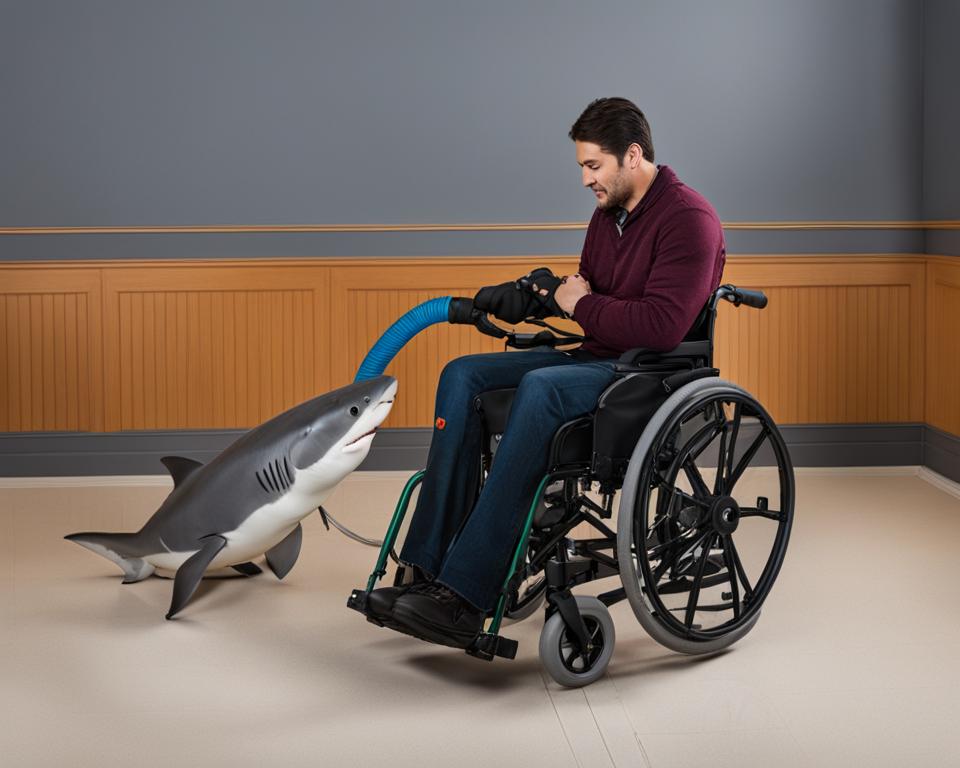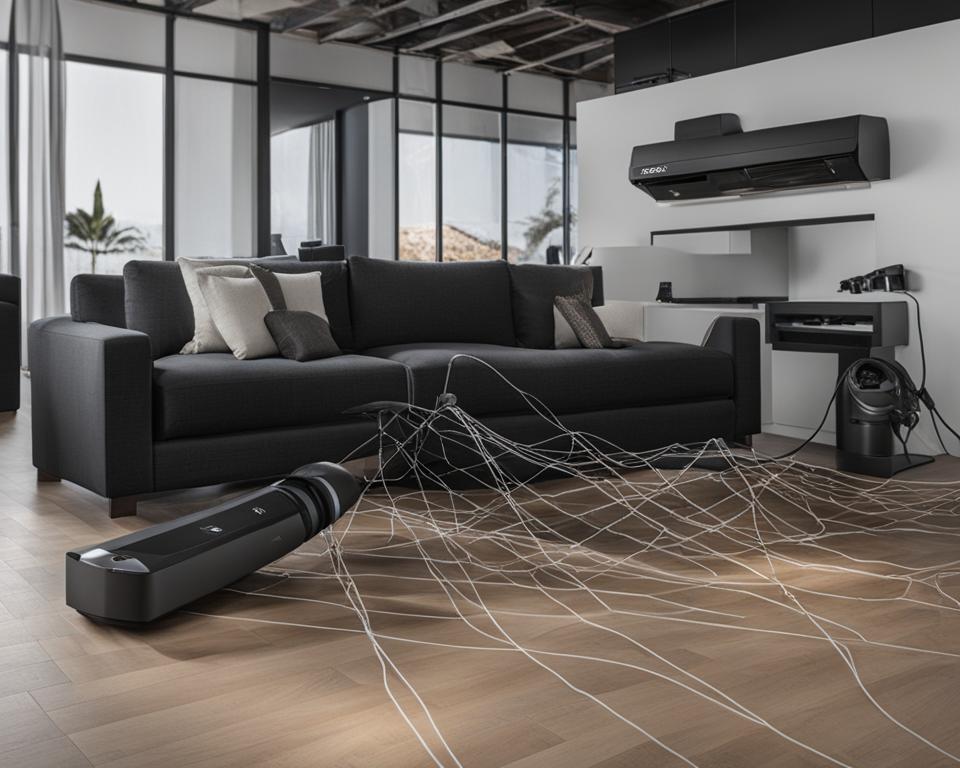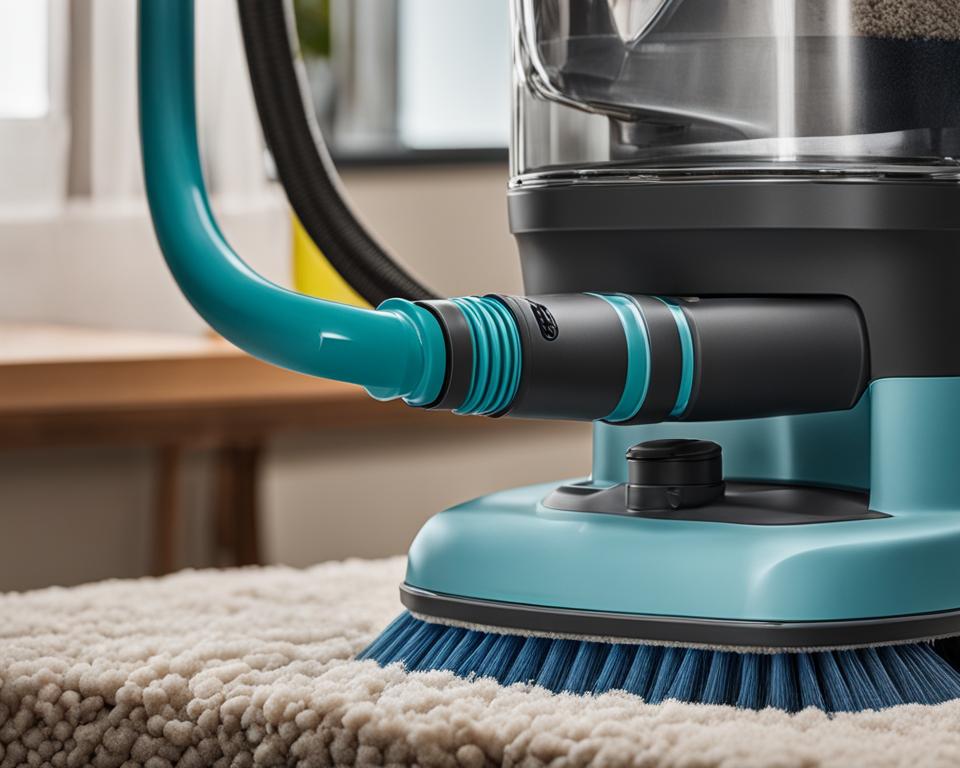Are you experiencing issues with your Shark vacuum? Don’t worry, we’ve got you covered. In this comprehensive DIY repair guide, we will walk you through common problems that may arise with your Shark vacuum and provide troubleshooting tips and solutions to get your vacuum up and running again.
Key Takeaways:
- Identify your Shark vacuum’s model number by checking the bottom of the box, the rating label on the back of the unit, or the instruction booklet.
- Common problems with Shark vacuums include power failure, loss of suction and overheating, limited mobility, and Wi-Fi connectivity issues.
- Power failure can be caused by a faulty AC outlet, motor issues, or wiring problems.
- Loss of suction and overheating can be resolved by removing blockages, cleaning the brushroll, and emptying the dirt tank regularly.
- Limited mobility can be improved by checking and cleaning the wheels, brushes, and brushroll.
- Wi-Fi issues can be fixed by checking network settings and router placement.
- If the brushroll is not spinning, it may be wrapped with hair or debris. Check the floor selector switch and consider replacing the micro switch if necessary.
Common SharkVacuum Problems and Troubleshooting Tips
If you own a Shark vacuum, it’s important to know how to troubleshoot common issues that may arise. By understanding these problems and their solutions, you can keep your Shark vacuum in optimal working condition and avoid unnecessary frustration. Below, we have outlined some of the most common SharkVacuum problems and provided troubleshooting tips to help you resolve them.
Power Failure
One of the common problems you may encounter with your Shark vacuum is power failure. If your vacuum is not turning on, the first step is to check the AC outlet. Try plugging in another device to see if it powers on. If the outlet is dead, check the electrical panel for a tripped breaker. If the outlet is functioning properly, the issue may lie with the vacuum’s motor or wiring. In such cases, it is recommended to seek professional servicing.
Loss of Suction and Overheating
Loss of suction and overheating are two other common problems that can occur with Shark vacuums. These issues are often caused by restricted airflow, a brushroll filled with hair, or a full dirt tank. To resolve the problem, start by checking for any blockages in the hoses or attachments, and remove any debris. Cleaning the brushroll and emptying the dirt tank regularly will also help to maintain optimal suction and prevent overheating.
Limited Mobility
If your Shark vacuum is experiencing limited mobility, it may be due to clogged wheels and brushes. Hair and debris can accumulate on the wheels and brushes over time, hindering their movement. To improve mobility, check the wheels and brushes for any clogs and remove any obstructions. This simple cleaning routine can significantly enhance your vacuum’s maneuverability and overall performance.
Wi-Fi Issues
For Shark robot vacuums with Wi-Fi connectivity, you may encounter issues with connecting to your home network. If you are experiencing Wi-Fi problems, ensure that you are inputting the correct network name and password during setup. Also, check if your router is set to the appropriate network band (2.4GHz), as some Shark vacuums may not be compatible with 5GHz networks. Consider repositioning your Wi-Fi router for better coverage, and if all else fails, try resetting your router by unplugging it for 10 seconds and then reconnecting it.
| Problem | Troubleshooting Tips |
|---|---|
| Power Failure | Check AC outlet and breaker. Seek professional servicing if necessary. |
| Loss of Suction and Overheating | Check for blockages, clean brushroll, and empty dirt tank regularly. |
| Limited Mobility | Clean wheels and brushes to remove clogs and debris. |
| Wi-Fi Issues | Ensure correct network settings and consider router repositioning. Reset router if needed. |
Power Failure: Troubleshooting Tips and Solutions
If you find that your Shark vacuum is not turning on, it could be due to a power failure. Before jumping to any conclusions, it’s important to check a few things to rule out any simple issues. Start by checking the AC outlet where your vacuum is plugged in. Plug in another device to see if it powers on. If the outlet is not working, check your electrical panel for a tripped breaker. Resetting the breaker should solve the power failure problem.
If the outlet is working fine and you’re still facing power failure with your Shark vacuum, the issue might lie with the vacuum’s motor or wiring. It’s important to note that attempting to repair the motor or wiring yourself can be complex and may void the warranty. It is recommended to seek professional servicing in such cases. A trained technician will assess the problem and provide the necessary repairs to get your Shark vacuum up and running again.
In cases where you are comfortable with DIY repairs and want to troubleshoot further, you can refer to the Shark vacuum’s user manual for specific instructions on how to check the motor and wiring. However, always proceed with caution and ensure your safety by disconnecting the vacuum from the power source before attempting any repairs or inspections.
| Possible Causes of Power Failure | Troubleshooting Steps |
|---|---|
| Faulty AC outlet | Check the outlet with another device |
| Tripped breaker | Reset the breaker in the electrical panel |
| Faulty motor or wiring | Seek professional servicing or refer to the user manual for further troubleshooting |
Loss of Suction and Overheating: Troubleshooting Tips and Solutions
Loss of suction and overheating are common issues that can affect the performance of your Shark vacuum. These problems can be frustrating, but with the right troubleshooting steps, you can resolve them and get your vacuum back to optimal working condition.
Restricted Airflow and Blockages
One of the main causes of loss of suction and overheating is restricted airflow due to blockages in the vacuum’s hoses or attachments. To address this issue, start by checking the hoses and attachments for any debris or clogs. Remove any obstructions that you find, and ensure that the airflow path is clear.
Additionally, it’s essential to clean the brushroll regularly. A brushroll filled with hair or debris can impede its rotation and lead to loss of suction. Remove the brushroll from the vacuum and clean it thoroughly, removing any tangled hair or debris that may be causing the issue.
Emptying the Dirt Tank
A full dirt tank can also contribute to overheating and reduced suction in your Shark vacuum. Regularly empty the dirt tank to prevent it from reaching its maximum capacity. This will help maintain optimal airflow and ensure that your vacuum performs at its best.
By addressing restricted airflow, blockages, and regularly emptying the dirt tank, you can troubleshoot and resolve loss of suction and overheating issues with your Shark vacuum. These simple steps can help you maintain the efficiency and longevity of your vacuum, ensuring that it continues to work effectively for years to come.
| Problem | Troubleshooting Tips | Solutions |
|---|---|---|
| Loss of Suction | Check for blockages in hoses and attachments Clean the brushroll |
Clear any debris or clogs Remove tangled hair or debris from the brushroll |
| Overheating | Ensure proper airflow by clearing blockages Regularly empty the dirt tank |
Remove any obstructions from hoses and attachments Empty the dirt tank to maintain optimal airflow |
Limited Mobility: Troubleshooting Tips and Solutions
If you’re experiencing limited mobility with your Shark vacuum, there are a few troubleshooting tips and solutions you can try to improve its performance. One common cause of limited mobility is clogged wheels and brushes. Over time, hair, debris, and other particles can get trapped in these components, affecting the vacuum’s ability to move smoothly.
To resolve this issue, start by checking the wheels for any clogs. Remove any hair or debris that may be hindering their movement. Next, inspect the brushes and clean them thoroughly. Remove any tangled hair or obstructions that may be preventing them from rotating properly. Cleaning the wheels and brushes can significantly improve your Shark vacuum’s mobility.
Table: Troubleshooting Tips for Limited Mobility
| Issue | Troubleshooting Tip |
|---|---|
| Clogged wheels | Remove hair and debris from the wheels. |
| Clogged brushes | Clean the brushes thoroughly to remove hair and obstructions. |
Additionally, make sure to regularly maintain your Shark vacuum by emptying the dirt tank and cleaning the filters. A full dirt tank can add extra weight and make it more difficult to maneuver the vacuum. By keeping the dirt tank empty, you’ll improve the overall mobility and suction power of your Shark vacuum.
If you’ve tried these troubleshooting tips and are still experiencing limited mobility with your Shark vacuum, it may be a sign of a more significant issue. In such cases, it’s recommended to reach out to a professional or authorized Shark service center for further assistance and repairs.

Wi-Fi Issues: Troubleshooting Tips and Solutions
If you are experiencing Wi-Fi connectivity issues with your Shark robot vacuum, there are several troubleshooting tips and solutions you can try to resolve the problem.
Check Network Settings and Connectivity
Ensure that you are inputting the correct network name and password during the initial setup of your Shark vacuum. Double-check for any typos or misspellings. It’s also important to select the appropriate network band, as some Shark vacuums may not be compatible with 5GHz networks. Make sure you are connecting to the 2.4GHz band, which is most commonly used for household devices.
Improve Wi-Fi Range and Positioning
If you are experiencing weak or intermittent Wi-Fi signal, try repositioning your Wi-Fi router for better coverage. Keep it away from obstructions such as walls and metal objects that can interfere with the signal. Additionally, check the range of your Wi-Fi router and consider investing in a Wi-Fi range extender to boost the signal throughout your home.
Reset Your Router
If you’ve tried all the above steps and your Shark vacuum still isn’t connecting to Wi-Fi, try resetting your router. Simply unplug it from the power source for about 10 seconds, then plug it back in. This can often resolve temporary connectivity issues and restore your vacuum’s ability to connect to the network.

| Issue | Troubleshooting Tips |
|---|---|
| Incorrect Network Settings | Double-check network name and password |
| Weak Wi-Fi Signal | Reposition Wi-Fi router and consider range extender |
| Intermittent Connectivity | Reset router by unplugging and reconnecting |
Brush Roll Not Spinning: Troubleshooting Tips and Solutions
If you’re experiencing issues with your Shark vacuum’s brush roll not spinning, there are a few potential causes and troubleshooting steps you can take to resolve the problem. One common reason for a non-spinning brush roll is that it may be wrapped with hair or debris. To address this, start by manually spinning the brush roll and visually inspecting it for any obstructions. If you see hair or debris tangled around the brush roll, remove it carefully to allow for proper rotation.
If the brush roll is still not spinning after removing any blockages, the next step is to check the floor selector switch. This switch controls the brush roll’s operation, and if it’s set to the wrong setting for the surface you’re cleaning, it may prevent the brush roll from spinning. Adjust the floor selector switch accordingly, ensuring it matches the type of flooring you’re vacuuming.
In some cases, a broken belt or a faulty micro switch can also cause the brush roll to stop spinning. If you’ve checked for hair or debris and adjusted the floor selector switch with no success, it may be necessary to replace these components. Replacement belts and micro switches can be obtained from authorized Shark service centers or professionals who specialize in vacuum repairs.
| Cause | Troubleshooting Steps |
|---|---|
| Brush roll wrapped with hair or debris | – Manually spin the brush roll and remove any obstructions – Clean the brush roll thoroughly |
| Incorrect floor selector switch setting | – Check and adjust the floor selector switch to match the surface you’re vacuuming |
| Broken belt or faulty micro switch | – Replace the belt or micro switch with compatible replacement parts |
By following these troubleshooting tips and solutions, you can resolve the issue of a non-spinning brush roll in your Shark vacuum. Remember to always refer to the instruction manual or seek professional assistance if you’re unsure or uncomfortable with DIY repairs.
Replacing the Shark Vacuum Micro Switch
If you’ve tried all the troubleshooting tips and your Shark vacuum’s brush roll still isn’t spinning, it may be time to replace the micro switch. The micro switch plays a crucial role in detecting the vacuum’s position and controlling the brush roll. A damaged micro switch can prevent the brush roll from spinning, affecting the vacuum’s overall performance.
Replacing the micro switch is a relatively simple repair that you can do yourself, provided you have the correct replacement part. Begin by consulting the user manual or contacting an authorized Shark service center to ensure you have the right micro switch for your model. Remember, if you’re uncomfortable with DIY repairs, it’s always best to seek professional assistance.
To replace the micro switch, start by disconnecting the vacuum from the power source and removing any attachments or accessories. Locate the micro switch, which is typically located near the brush roll and connected to the vacuum’s motor or control board. Carefully disconnect the wiring harness from the old micro switch.
Next, remove the old micro switch by unscrewing or unclipping it from its mounting. Take note of the orientation and positioning of the switch before removing it. Install the new micro switch in the same position, ensuring it is securely attached and aligned properly. Reconnect the wiring harness to the new micro switch, double-checking that the connections are secure.
Once the new micro switch is in place, reattach any pieces you removed during the replacement process. Finally, reconnect the vacuum to the power source and test the brush roll. If all goes well, your Shark vacuum should now be back to its optimal performance, with the brush roll spinning as it should.
FAQ
How can I identify the model number of my Shark vacuum?
You can check the bottom of the box, the rating label on the back of the unit, or the instruction booklet to find your Shark vacuum’s model number.
What are some common issues that can arise with Shark vacuums?
Common issues include power failure, loss of suction and overheating, limited mobility, and Wi-Fi connectivity problems (for robot vacuums).
What should I do if my Shark vacuum is not turning on?
Check the AC outlet and try plugging in another device to see if it powers on. If the outlet is dead, check the electrical panel for a tripped breaker. If the issue persists, it may be a faulty motor or wiring, and professional servicing is recommended.
How can I resolve loss of suction and overheating with my Shark vacuum?
Check for restricted airflow due to blockages in hoses or attachments and remove any obstructions. Clean the brushroll if it is filled with hair. Empty the dirt tank regularly to prevent overheating and maintain suction.
What should I do if my Shark upright vacuum is harder to push or my Shark robot vacuum is not moving properly?
Check the wheels and brushes for clogs and remove any hair or debris. Clean the brushroll for tangles or obstructions. This can improve the mobility and performance of your vacuum.
How do I troubleshoot Wi-Fi issues with my Shark robot vacuum?
Ensure you input the correct network name and password during setup. Choose the appropriate network band (2.4GHz). Check your Wi-Fi router’s range and consider repositioning it for better coverage. If all else fails, try resetting your router.
What can I do if the brush roll on my Shark vacuum is not spinning?
Manually spin the brush roll to check for obstructions and remove any hair or debris. Ensure the floor selector switch is set correctly. If the issue persists, it may be a broken belt or a faulty micro switch that needs replacement.
How do I replace the micro switch in my Shark vacuum?
The micro switch controls the brush roll. If the brush roll is not spinning despite other troubleshooting attempts, it may be due to a damaged micro switch. Consult a professional or authorized Shark service center for assistance with replacing the micro switch.

Leave a Reply